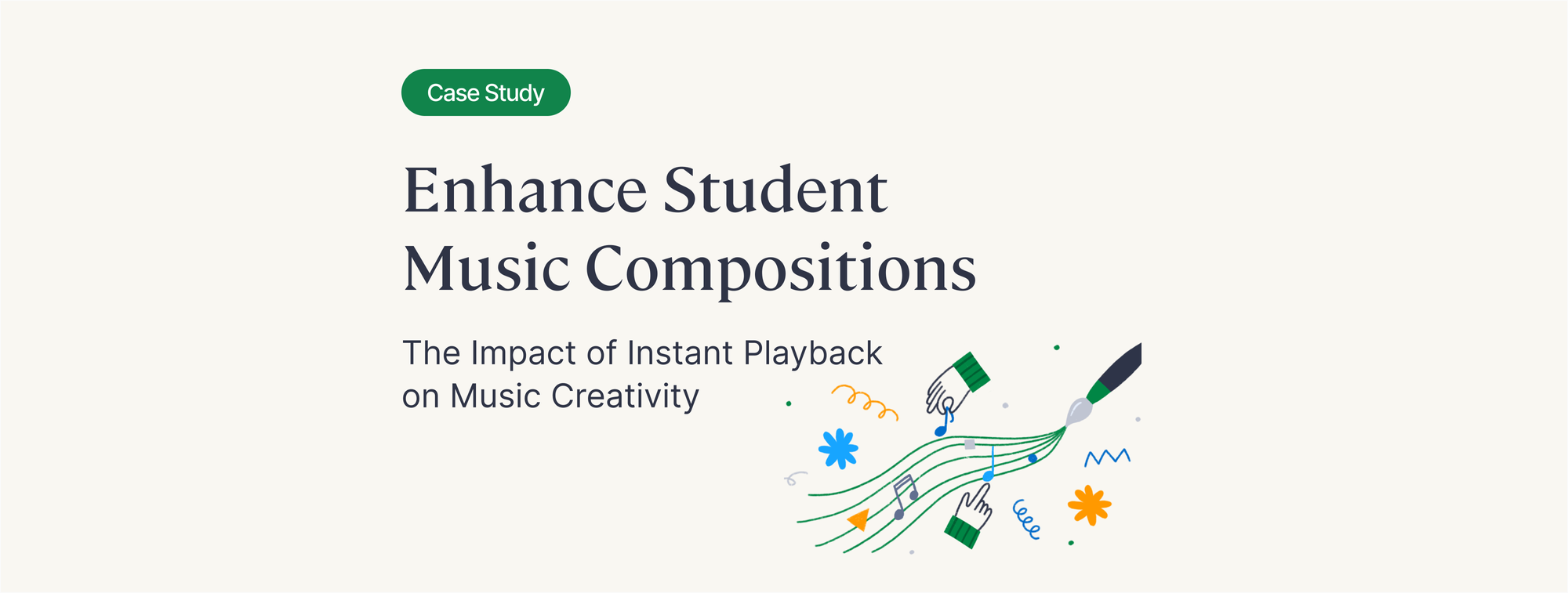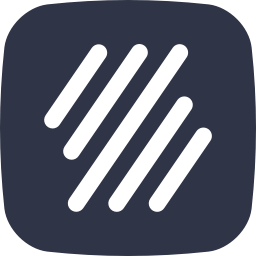At Flat for Education, we love talking to our users! Recently, we had a conversation with Adam Grenon, a high school music teacher in Ontario, Canada. In the following article, we'll explain how he uses Flat for Education features, such as instant playback, to address two common issues faced by music teachers: teaching multiple grade levels simultaneously and bridging the gap between theory and practice in music. Stick around to discover practical solutions to these challenges.
High school music teacher Adam Grenon has long faced two big challenges in his classes that we believe you can relate to:
- Multiple grade levels taught during the same class time, meaning that he must simultaneously cover two different curriculums. Plus, even within the same grade, he ends up having a wide variety of student skill levels that can range from complete beginners to experienced musicians who have taken years of lessons.
- The gap between theory and practice, as students struggle to see how written compositions translate into physical sounds.
Thanks to his vast experience and curiosity about music education, Adam has found assertive solutions that you can also put into practice. Let's dive into it!
Challenge 1: Teaching two music curriculums at the same time
Adam has been using Flat for Education for several years and was especially thankful for it when teaching in person became more difficult due to the COVID-19 pandemic. The pandemic made things tough for everyone, but music classes faced extra challenges. In Canada, Adam found that some music classes couldn't be taught at all for two whole school years.
“Canada had some of the tightest overall restrictions, and within those the absolute tightest were on music. We couldn’t sing in class for almost two years, we couldn’t play in band class… We could play some guitar, because it’s not about air movement. Our music program is still recovering from those years, we’re only now getting back to where we were.”
Adam has been asked to teach more combined classes, known as "splits," because fewer students are signing up for music. This means he teaches two different classes at the same time, combining Grade 11 and Grade 12 guitar students into one class. This approach allows the school to keep offering these music classes instead of canceling them.
By grouping different grades together, the school can make sure that students still have the chance to learn music, even when there are fewer students in each grade interested in taking music classes. This way, all students who want to learn guitar, for example, can continue their education without interruption.
Adam faces a tough task: teaching two different music classes at the same time. But, according to his experience, Flat for Education has been incredibly helpful in managing this. Now, whether his students are learning guitar or keyboard, they can connect their instruments to their headphones and Chromebooks. This way, they can follow lessons tailored to their own level.
A great feature available in our platform to achieve this is the ability to distribute assignments to individual students or groups.

💡 To read more about this feature and learn how to make the most out of it, check out our step-by-step tutorial below.

More than that, Adam can then give personalized attention to each student, answering questions and guiding them. This setup allows every student to learn at their own pace, staying engaged with their specific curriculum. For this, our inline comments are the best solution. With this feature, the classroom transforms into a dynamic space that supports each student's growth and achievement.

💡Learn how to use this feature in our dedicated guide > here.
If you want to learn more about all the available features to tailor your assignments to suit your students' needs, check out our article below.
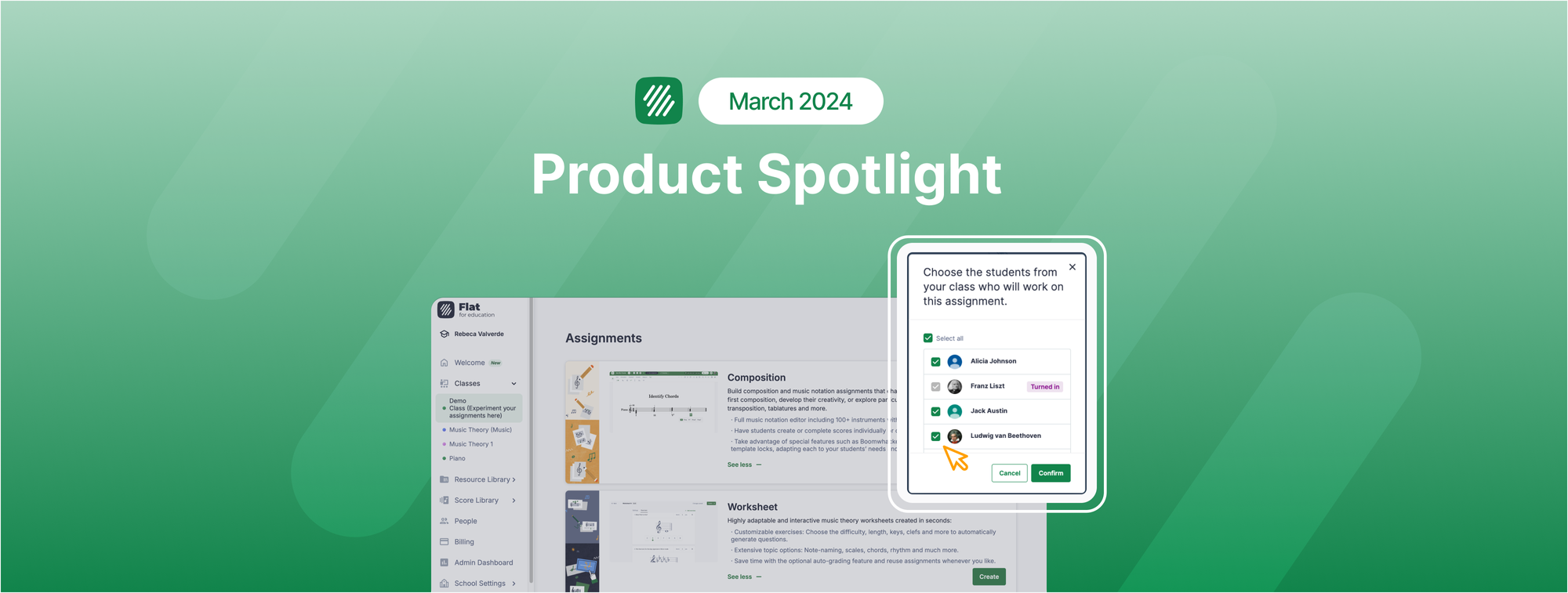
Challenge 2: Bridging the gap between theory and practice in music
For Adam, the gap between theory and practice was most notable in one key area of the day-to-day routine of teaching music composition.
Having students go from writing notes on a piece of paper to actually understanding what those notes sound like was extremely difficult, if not impossible.
Adam points out a few issues within this particular problem:
- The simple question of legibility, whether or not he could decipher the notes students put on the page;
- Whether or not the composition made sense through the meter;
- The issue of playback. After all, if a student doesn’t have the ability to simultaneously read and play music, they can’t easily produce the sounds they’ve written. And even if he wanted to, time constraints mean Adam himself can’t play every composition that students would produce in his class.
With Flat for Education, Adam found that he is better able to face all of those problems, with students able to learn how to compose music better and faster.
The instant playback available in Flat for Education take all the guesswork out of reading the notes. Adam provides the composition template, ensuring that everything will work with the selected meter. And most importantly, the ability to hit “play” on their compositions means students can write notes and instantly hear how they sound.
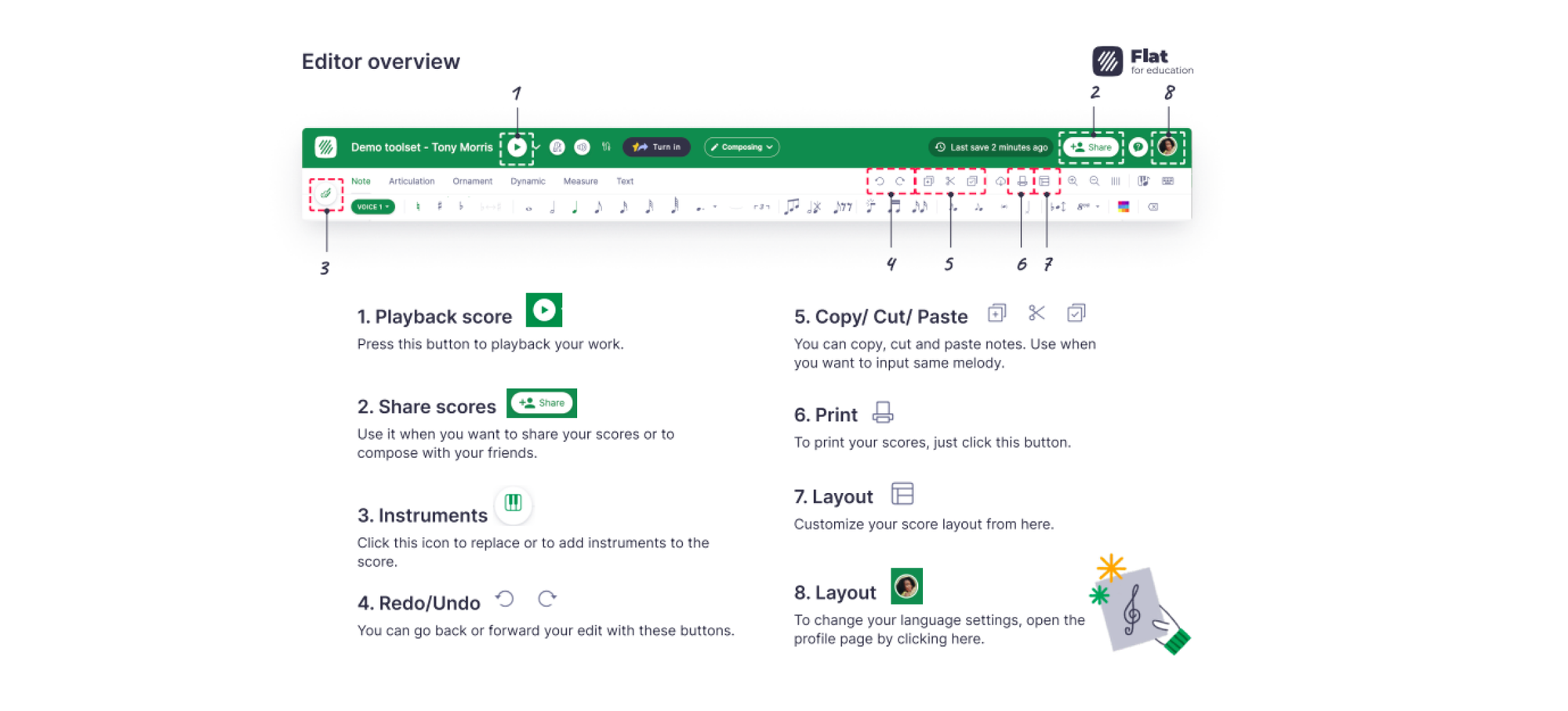
The most important Flat for Education feature from an engagement perspective is just how easy it is to start using. Even for beginners who don’t know what all of the buttons might do, the music notation editor is an easy-to-use space for experimentation.
Having used it with a variety of age and experience levels, Adam’s message is clear:
“Kids understand it pretty intuitively”
💡 If you are looking for a guide on how to help your students get started with Flat for Education, we have the perfect resource for you.
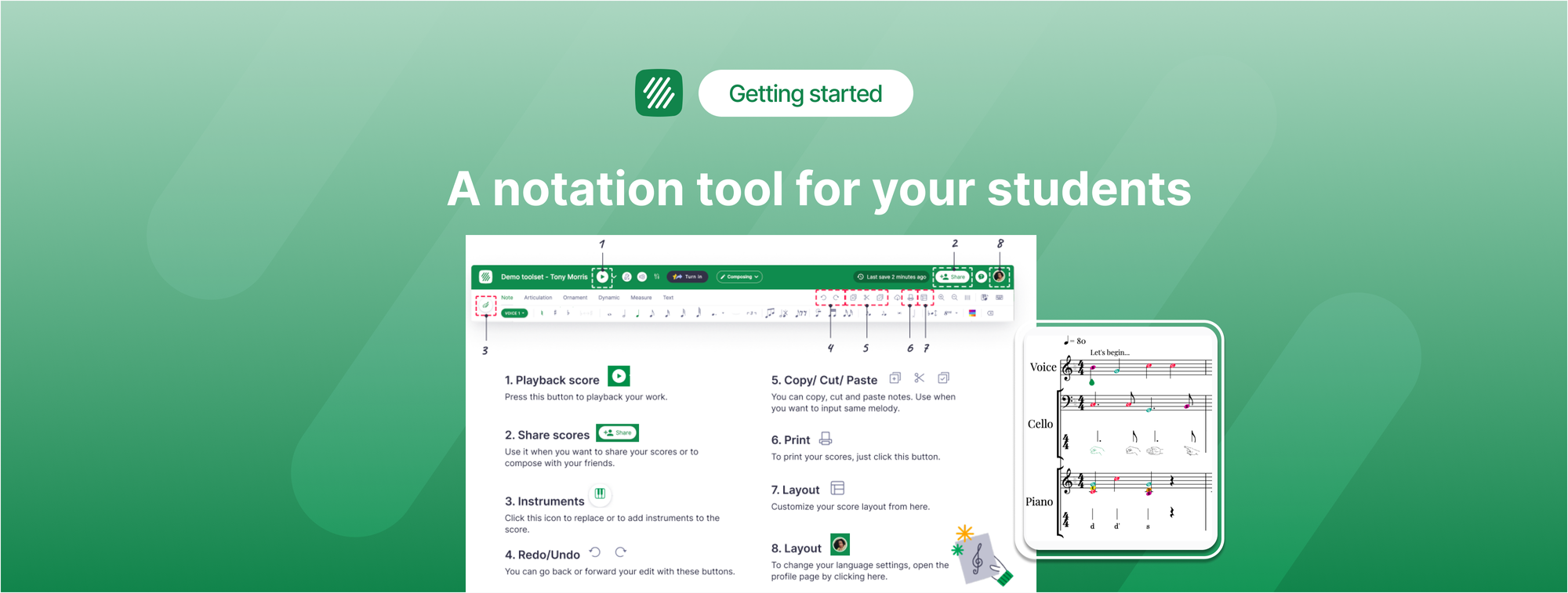
When his students first begin using Flat for Education, Adam keeps things simple. Using their Chromebooks, students simply take a blank composition and click around to add notes to the staff. As students experiment with the editor, they always have a composition where they can hit ‘Play’ and hear the corresponding sounds.
💡Learn all about our playback features in our guide below:
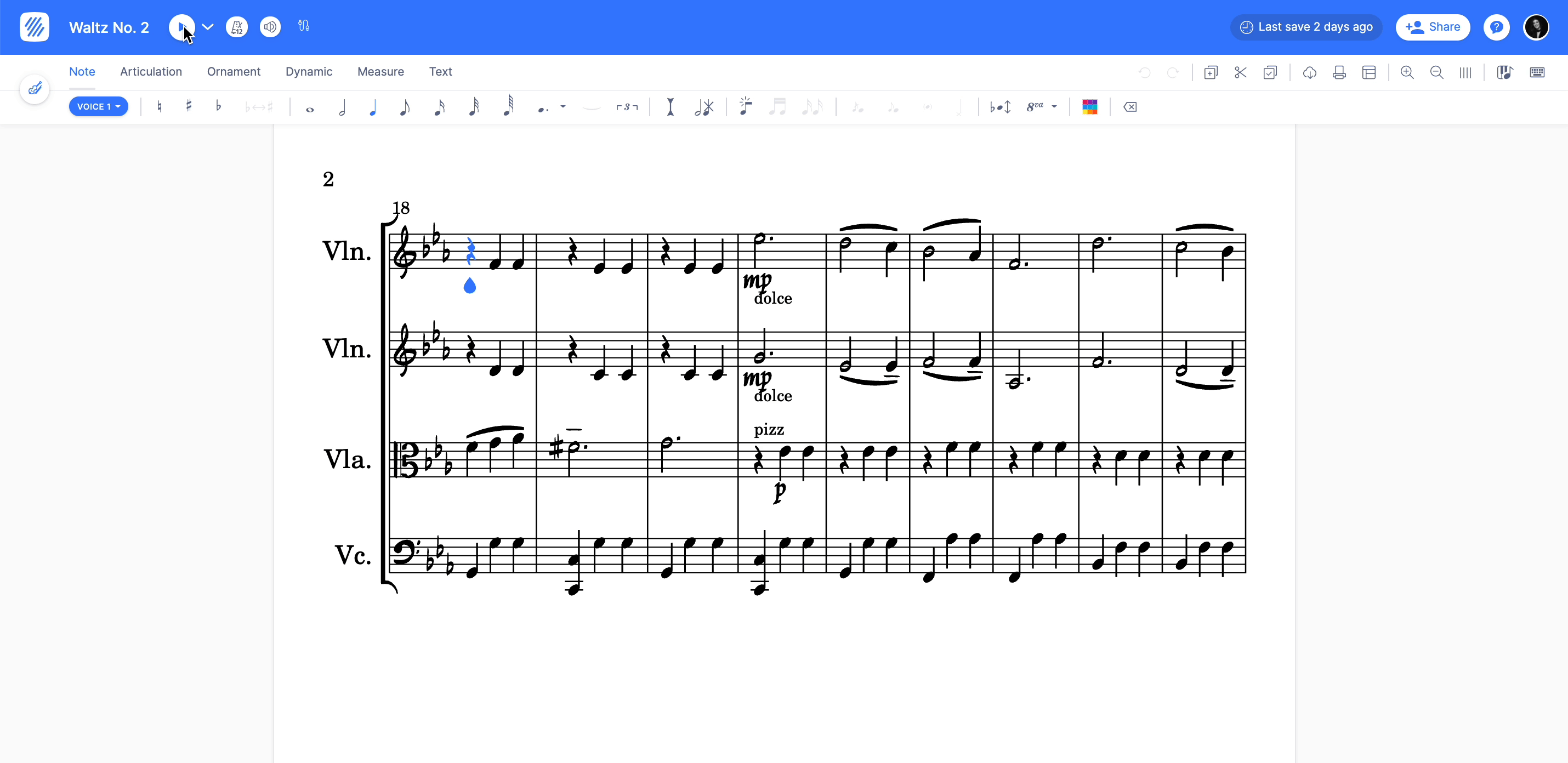
Next, Adam presents a three-bar partial melody. He’ll add the rests and ask students to fill in the bar. Students then volunteer to share what they’ve written, giving the class an opportunity to talk about what they notice between the notes on the page and the sounds they hear.
“What’s so valuable about using Flat is that there’s no wrong answer! The students get to try, we listen, they’re just making music. The first thing they see is that 27 kids will write 27 different things, even for just one bar. And when we talk about it, they spot patterns: Here, it sounds like we’re missing a note at the end. Here, see how this one started on C and ended on C? That sounded pretty good. And so on.”
This ability for instant playback helps students discover some rules for composing themselves. And Adam can then add in some music history by taking famous melodies – John Williams, Beethoven, pop – and showing how the rules are applied in those pieces.
Plus, because it’s so easy to pick up, students often deliver even more than is required. While Adam might give an assignment to complete a 3-bar composition, he frequently has students that write more, for example turning in 30 bars. Importantly, they aren’t just randomly tapping in notes. As Adam says,
“They spend hours working on these things because they love it.”
How instant playback improves your students' music composing skills
Creating a solid link between theory and practice through our instant playback feature lets students move into more engaging projects, which in turn push the learning curve even higher.
Students are able to have more in-depth conversations about music, such as identifying the reasons why one doesn’t create a melody between a trumpet and a violin. They can experiment with different types of music, such as atonal music, gaining an intuitive sense of why they like them or not. And they’re eager to take part in engaging assignments, which is one of the most gratifying results for any teacher.
Adam gave one recent example that he created with the help of a friend who produces horror podcasts. Last year, when his class wanted to do a composition project, Adam came up with a very real world situation for them to work on.
“I had my friend record the text. My students took that recording, listened, and then wrote the music that would go underneath the text. And there were some that, very honestly, sounded like they could have been published. That’s a level of composing that, in our classroom, simply wouldn’t have been possible without Flat.”
What is Flat for Education?
Flat for Education streamlines music teaching. It offers easy lesson and assignment creation, grading, and feedback. With its intuitive notation editor, diverse music theory worksheets, engaging activities, and a Resource Library, it integrates smoothly with classroom tech. Its blend of power and ease of use makes it popular with over 10,000 teachers and 2 million students worldwide.
Many thanks to Adam for joining us and sharing a look at his musical classroom 🎼 🎼 If you’d like to find out more about how Flat for Education could transform your teaching routine, check out its full list of features here.
